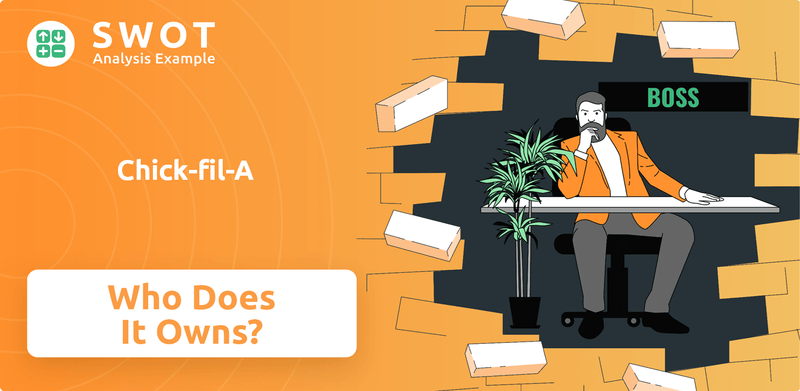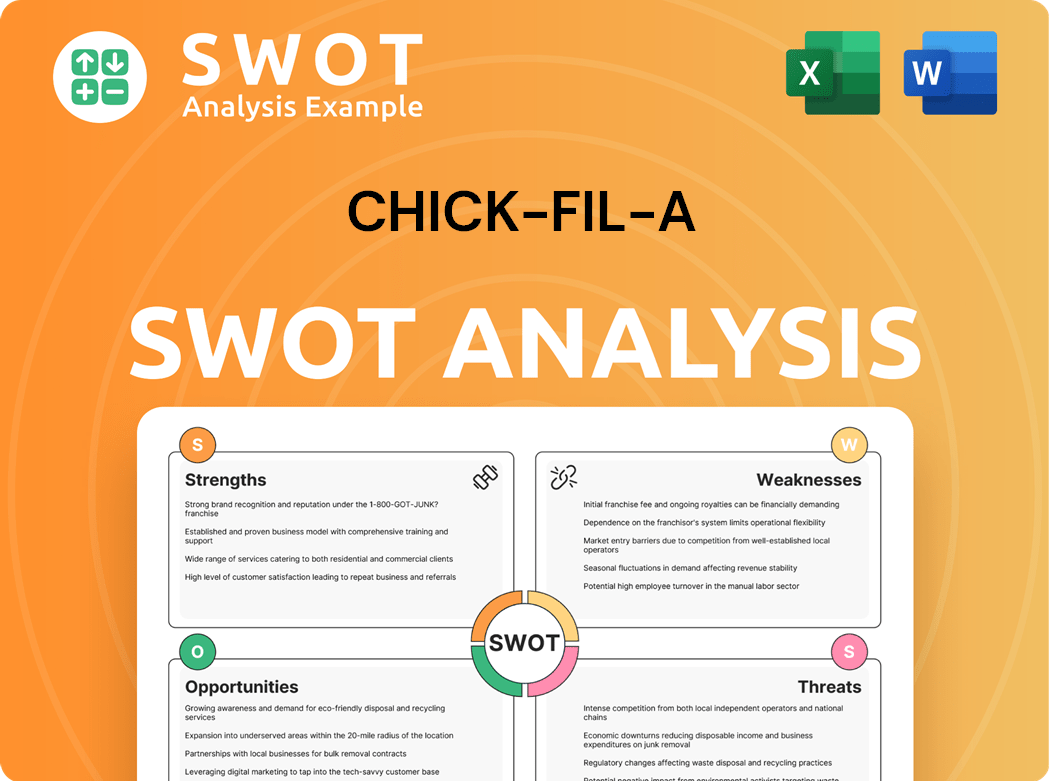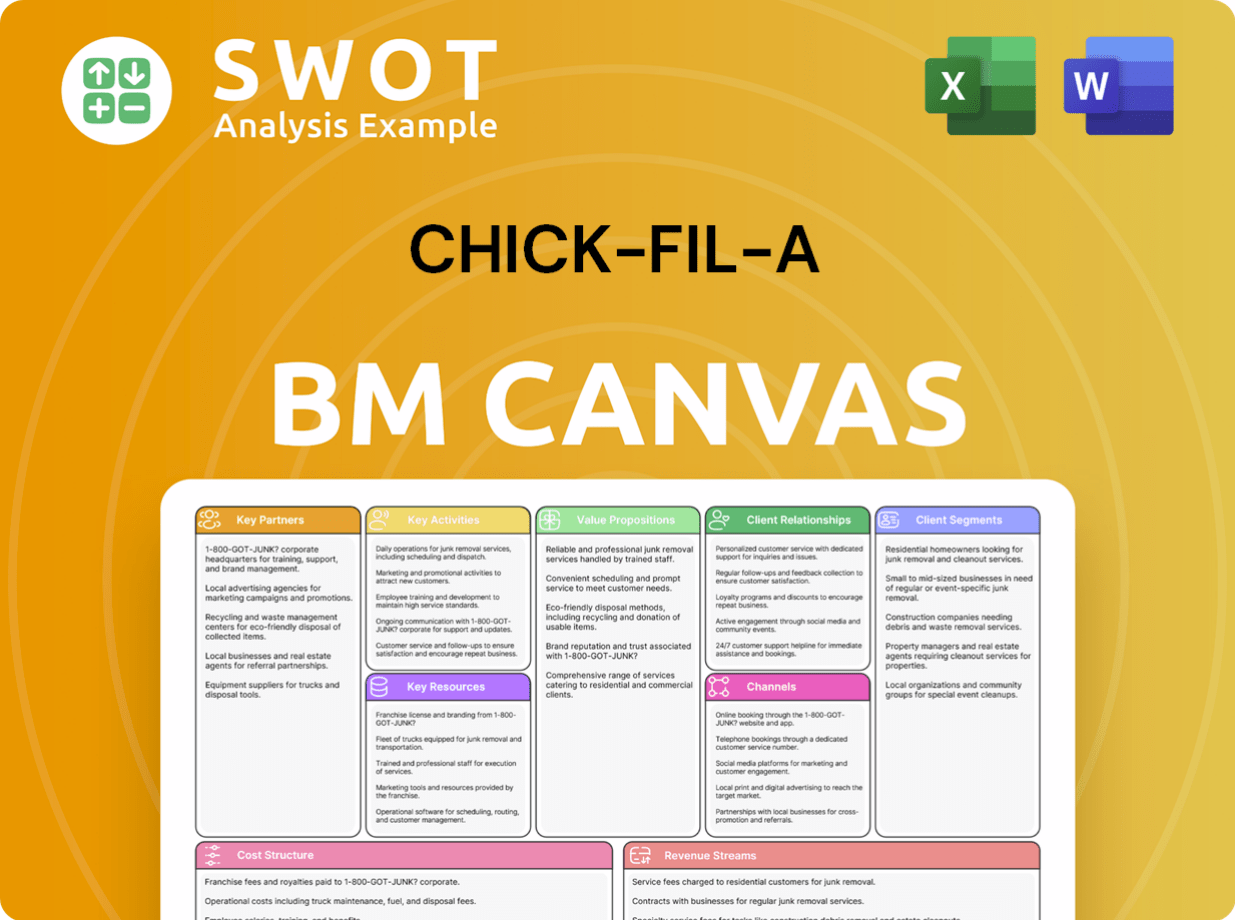Chick-fil-A Bundle
Who Really Owns Chick-fil-A?
Unraveling the Chick-fil-A SWOT Analysis is key to understanding its impressive success. Unlike many fast-food giants, Chick-fil-A operates under a unique ownership model. This distinctive structure influences its strategic decisions and long-term vision, setting it apart in the competitive market. Discover the secrets behind the Chick-fil-A company's enduring influence.

The question of "Who owns Chick-fil-A?" goes beyond simple corporate structure; it delves into the heart of its values and operational philosophy. Founded by Truett Cathy, the company's private ownership has allowed it to prioritize quality and customer service. Understanding the Chick-fil-A owner and the Cathy family's ongoing role provides essential insights into its continued success and market position, especially considering the company's impressive revenue and expansion.
Who Founded Chick-fil-A?
The story of Chick-fil-A's brief history begins with its founder, S. Truett Cathy, and his singular vision. Cathy established the company, starting with the Dwarf Grill in 1946, which later evolved into the first Chick-fil-A restaurant in 1967. This early phase was defined by Cathy's sole ownership, shaping the company's values and operational strategies from the outset.
From its inception, the ownership of Chick-fil-A was firmly in the hands of S. Truett Cathy. This structure allowed him to instill his personal values and business philosophy directly into the company's operations. There were no external investors or shareholders during this foundational period. The company's growth was fueled by the success of its restaurants, emphasizing a self-funded model.
Cathy's approach extended to the company's unique franchising model. Unlike many fast-food chains, Chick-fil-A operators do not own their restaurants. Instead, they are selected and invest a relatively small amount, around $10,000 as of 2024, to become an operator. This model ensures that the company maintains significant control over its brand and customer experience.
S. Truett Cathy founded Chick-fil-A and maintained sole ownership initially.
The company's origins trace back to the Dwarf Grill in 1946.
The first Chick-fil-A restaurant opened in 1967.
Early growth was primarily self-funded, without external equity partners.
Chick-fil-A operators do not own their restaurants, maintaining brand control.
Operators invest a minimal amount, around $10,000, to run a restaurant.
The centralized control under S. Truett Cathy allowed for consistent adherence to his operational standards. This early structure, with 100% ownership by Cathy, facilitated a focus on long-term stability and value creation. The company's structure has remained a closely held family business, which is a key aspect of understanding who owns Chick-fil-A and its corporate structure. As of 2023, Chick-fil-A had over 2,800 locations across the United States, and the Cathy family continues to play a significant role in the company's leadership.
Understanding the Chick-fil-A ownership structure is crucial for grasping its business model.
- S. Truett Cathy founded and initially solely owned the company.
- The franchising model ensures brand control and consistent quality.
- Operators invest a minimal amount to run their restaurants.
- The company's structure has remained a closely held family business.
- As of 2023, there are over 2,800 locations.
Chick-fil-A SWOT Analysis
- Complete SWOT Breakdown
- Fully Customizable
- Editable in Excel & Word
- Professional Formatting
- Investor-Ready Format

How Has Chick-fil-A’s Ownership Changed Over Time?
The evolution of Chick-fil-A's ownership is marked by its unwavering commitment to remaining a privately held entity. This decision, made since its inception, sets it apart from many competitors in the fast-food sector. This strategic choice allows the Cathy family to maintain firm control over the company’s operations, values, and long-term goals, free from the constraints of public shareholders and the pressure of quarterly earnings.
The most significant event impacting Chick-fil-A's ownership was the passing of founder S. Truett Cathy in 2014. This transition marked a shift to the second and third generations of the Cathy family, ensuring the continuity of the family's influence and the company's core values. Dan T. Cathy, Truett Cathy’s son, currently serves as Chairman, while his brother Bubba Cathy is the Executive Vice President. Andrew Cathy, Dan's son, took over as CEO in 2021, solidifying the family's ongoing leadership role.
| Key Event | Impact on Ownership | Year |
|---|---|---|
| Founding of Chick-fil-A | Establishment of private ownership by S. Truett Cathy | 1967 |
| Death of S. Truett Cathy | Transition of leadership to the second generation (Dan T. Cathy) | 2014 |
| Andrew Cathy becomes CEO | Further transition to the third generation of the Cathy family | 2021 |
The privately held status of Chick-fil-A has allowed for consistent reinvestment into the business, supporting its growth and maintaining high operational and customer service standards. The company's unique franchise model also plays a role, with operators managing restaurants but not holding equity in Chick-fil-A, Inc. This structure, combined with family ownership, has contributed to its success, with system-wide sales reaching approximately $18.8 billion as of 2023. This is a testament to the effectiveness of the privately controlled, family-led approach. For a deeper understanding of the company's strategy, consider exploring the Target Market of Chick-fil-A.
Chick-fil-A's ownership is entirely within the Cathy family, ensuring tight control and a focus on long-term goals.
- The company is privately held, avoiding the pressures of public shareholders.
- Leadership has transitioned through generations of the Cathy family.
- Franchise operators do not have equity in the parent company.
- The company reinvests earnings to support growth and maintain high standards.
Chick-fil-A PESTLE Analysis
- Covers All 6 PESTLE Categories
- No Research Needed – Save Hours of Work
- Built by Experts, Trusted by Consultants
- Instant Download, Ready to Use
- 100% Editable, Fully Customizable

Who Sits on Chick-fil-A’s Board?
The Board of Directors at Chick-fil-A, Inc. oversees the company's operations, operating within its private, family-owned structure. Information about the board members is not fully public due to the company's private status. However, the board is primarily composed of members of the Cathy family, along with a selection of non-family executives and independent directors. This composition ensures that the family's vision and values are central to the company's strategic decisions. The primary focus remains on maintaining the company's unique culture and commitment to its values, including its well-known practice of being closed on Sundays.
Key board members include top leaders such as Chairman Dan T. Cathy and CEO Andrew Cathy, both representing the founding family's ownership and legacy. Their presence ensures alignment between the owners' long-term objectives and the company's operational strategies. The private nature of Chick-fil-A means there are no complex voting structures typically found in public companies. The Cathy family, as the primary owners, holds the ultimate voting power and control over the company's direction. The company's structure allows a focus on long-term goals and adherence to its foundational principles.
| Board Member | Title | Role |
|---|---|---|
| Dan T. Cathy | Chairman | Oversees the company's strategic direction and upholds family values. |
| Andrew Cathy | CEO | Leads the company's operations and ensures alignment with the board's vision. |
| Other Directors | Various | Include family members, executives, and independent directors who contribute to strategic decisions. |
Given its private ownership, Chick-fil-A is not subject to proxy battles or activist investor campaigns that often challenge the boards of public corporations. This allows the company to focus on its long-term goals and adherence to its foundational principles. The board's decisions are largely influenced by the family's stewardship philosophy, prioritizing sustainable growth and brand integrity. The company's growth strategy, detailed in Growth Strategy of Chick-fil-A, reflects this focus on long-term value and maintaining its unique operational model.
The Cathy family primarily controls Chick-fil-A, ensuring decisions align with their values. The board includes family members and key executives. The company's private status allows it to focus on long-term goals.
- The Cathy family holds the ultimate voting power.
- The board prioritizes sustainable growth and brand integrity.
- Chick-fil-A is not subject to external pressures like public companies.
- The company's structure supports its unique operational model.
Chick-fil-A Business Model Canvas
- Complete 9-Block Business Model Canvas
- Effortlessly Communicate Your Business Strategy
- Investor-Ready BMC Format
- 100% Editable and Customizable
- Clear and Structured Layout

What Recent Changes Have Shaped Chick-fil-A’s Ownership Landscape?
In recent years, the Chick-fil-A company has seen key developments centered around its ownership and leadership. A significant change was the 2021 transition of the CEO role from Dan T. Cathy to his son, Andrew Cathy. This succession highlights the family's commitment to maintaining the business as a privately held entity, reinforcing the long-standing values established by founder Truett Cathy. This move ensures that the company remains under family control, avoiding the influence of external shareholders and maintaining its unique corporate culture.
The company has been expanding its presence, both domestically and internationally, while remaining privately owned. With over 3,000 locations, primarily in the U.S., Chick-fil-A is exploring growth in new markets. This expansion is funded through reinvestment of its substantial earnings, rather than through external financing. The company's financial performance, with system-wide sales estimated at $18.8 billion in 2023, provides the resources for organic growth, allowing the Cathy family to retain complete control over strategic decisions.
| Aspect | Details | Data |
|---|---|---|
| Ownership Structure | Private, Family-Owned | Controlled by the Cathy family |
| CEO | Andrew Cathy | Succeeded Dan T. Cathy in 2021 |
| Locations | Primarily in the U.S. | Over 3,000 locations |
| 2023 System-Wide Sales | Estimated | $18.8 billion |
The private ownership structure of Chick-fil-A allows the Cathy family to avoid many industry trends, such as increased institutional ownership or the dilution of founder stakes. The family's decision to remain private allows them to maintain complete control over strategic choices, including brand image, operational policies, and philanthropic endeavors. There are no indications of a potential public listing, solidifying the expectation that Chick-fil-A will continue as a privately held, family-owned enterprise.
Chick-fil-A is primarily owned and controlled by the Cathy family. The company's founder, Truett Cathy, established the family's ownership, and the leadership has passed to his descendants.
In 2021, Andrew Cathy took over as CEO, succeeding his father, Dan T. Cathy. This transition ensures the family's continued involvement in the company's direction and management.
The company is expanding both domestically and internationally, with a focus on organic growth. This expansion is supported by strong financial performance and reinvested earnings.
Chick-fil-A is expected to remain a privately held, family-owned business. This structure allows the company to maintain control over its values and strategic decisions.
Chick-fil-A Porter's Five Forces Analysis
- Covers All 5 Competitive Forces in Detail
- Structured for Consultants, Students, and Founders
- 100% Editable in Microsoft Word & Excel
- Instant Digital Download – Use Immediately
- Compatible with Mac & PC – Fully Unlocked

Related Blogs
- What are Mission Vision & Core Values of Chick-fil-A Company?
- What is Competitive Landscape of Chick-fil-A Company?
- What is Growth Strategy and Future Prospects of Chick-fil-A Company?
- How Does Chick-fil-A Company Work?
- What is Sales and Marketing Strategy of Chick-fil-A Company?
- What is Brief History of Chick-fil-A Company?
- What is Customer Demographics and Target Market of Chick-fil-A Company?
Disclaimer
All information, articles, and product details provided on this website are for general informational and educational purposes only. We do not claim any ownership over, nor do we intend to infringe upon, any trademarks, copyrights, logos, brand names, or other intellectual property mentioned or depicted on this site. Such intellectual property remains the property of its respective owners, and any references here are made solely for identification or informational purposes, without implying any affiliation, endorsement, or partnership.
We make no representations or warranties, express or implied, regarding the accuracy, completeness, or suitability of any content or products presented. Nothing on this website should be construed as legal, tax, investment, financial, medical, or other professional advice. In addition, no part of this site—including articles or product references—constitutes a solicitation, recommendation, endorsement, advertisement, or offer to buy or sell any securities, franchises, or other financial instruments, particularly in jurisdictions where such activity would be unlawful.
All content is of a general nature and may not address the specific circumstances of any individual or entity. It is not a substitute for professional advice or services. Any actions you take based on the information provided here are strictly at your own risk. You accept full responsibility for any decisions or outcomes arising from your use of this website and agree to release us from any liability in connection with your use of, or reliance upon, the content or products found herein.